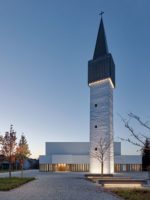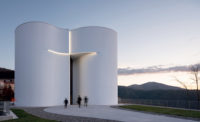You could say it was a match made in heaven. When the congregation of the aging Christus Church in Hannover, Germany joined forces with a local girls’ choir, a partnership was formed that enabled the restoration of the historic Lutheran house of worship while creating a striking new venue for musical training and performance.
Additional Information:Jump to credits & specifications
Though the facade of the 1864 Neo-Gothic edifice by architect Conrad Wilhelm Hase had been rehabilitated in the 1980s, the interior remained largely neglected—the paving was damaged, the walls were discolored with age, and the building lacked heating. In 2011, local officials came up with the idea of pairing the church with the internationally celebrated Hannover Girls’ Choir, which had outgrown its rehearsal space in a nearby high school and was looking to upgrade its facilities. The brief that resulted from this union required two seemingly disparate goals: the renovation of the landmark building for use as a church and its redesign as a choir center, which would include five rehearsal rooms. “The church had to remain a church,” says Roger Ahrens, principal of Hannover-based ahrens & grabenhorst architects and planners, noting that the challenge became one of inserting the new program in such a way that it would not disrupt the building’s primary purpose.
Approaching the redesign, the architects, with an extensive portfolio of new-construction and adaptive-reuse work, easily located four small choral practice rooms in the 230-foot-high church tower. The requirement to create a larger, 1,725-square-foot self-contained rehearsal space proved much more daunting. Then the team came up with a bold idea: remove the pews from the nave and build the rehearsal room in their place. To recoup the lost seating for worshippers (as well as that for future concertgoers attending performances in the main space), the architects topped the rehearsal room with oak bleachers, consisting of fifteen risers that seat up to 288 people and ascend to a height of 20 feet, stopping at the nave’s rear wall. “Since the architecture is vertical,” says Ahrens, “we decided to start with the floor and fold it upwards.” The bleachers intersect the muscular brick columns yet are structurally independent of them, supported by a steel- reinforced concrete frame, which is flanked by steel beams. The architects exposed this structure in the practice room below, painted it white, and added routed, bowed oak panels for acoustics and to imbue the space with an intimate quality. The room’s sides employ louvered glazing, which visually connects it to the larger church while optimizing sound quality and aiding ventilation.
Municipal building regulations mandated additional exits for concert venues. So the architects reopened the north and south entries, which had been sealed off in the 1950s. To create vestibules, they built large, freestanding oak partitions in front of each entrance. The upper portions of these walls are angled in to improve acoustics. Upon entering the church on a brisk winter day, the bleachers and partitions, unified by their honey-toned oak, lend the cavernous interior a surprising feeling of warmth and welcome. This sensation is reinforced by amenities like radiant floor heating, installed under taupe porcelain tile, and LEDs above the nave that cast a warm light into the space.
To respect the historic architecture while optimizing sound quality and enhancing user comfort, the architects worked with a light hand. Even painting the interiors, for example, the team was careful to allow the structural brick elements—the columns and the ribs of the groin vaults—to remain unpainted to retain their visual prominence, as Hase had intended. To buffer against noise from traffic and provide thermal insulation, the architects covered the interior of the stained-glass windows with double glazing, fastening the new layer onto delicate steel frames. Eleven-foot-high fiberboard paneling covers the base of the walls along the nave, transept, and sections of the altar, to improve acoustics. When glimpsed from the bleachers, this lacquered, matte white surface seems to match the wall’s stucco finish. Even the gold-plated stars, facsimiles of historic details that adorn the vaults, have a bitumen coating on their backs to absorb sound.
It is this attention to detail that makes ahrens & grabenhorst’s renovation of the Christus Church such a success and allows the architecture to shine while bringing it up to date for the contemporary needs of both the congregation and the choir. The church remains a church, but now youthful voices enrich encounters with the sacred. “Between May and October, the door stays open,” says pastor Stefanie Sonnenburg. “Visitors come here to find a quiet place. Often, the girls’ choir is rehearsing, and people are delighted to be able to experience this building in its new function too.”
CreditsArchitect: ahrens & grabenhorst architekten stadtplaner BDA www.ahrensgrabenhorst.de phone: +49 (0)511- 300 3460
Personnel in architect's firm who should receive special credit: Founders: Prof. Gesche Grabenhorst, Roger Ahrens
Engineers Meier Ing.-Büro für Baustatik und Konstruktion, info@statikmeier.de
Consultants Dr.-Ing. Meihorst und Partner, Beratende Ingenieure für Bauwesen GmbH
Photographer: Roland Halbe
|
SpecificationsStructural System Steel beams with wood cladding, precast concrete
Exterior Cladding Metal panels: Restauration Metal: Vera Fendel, fendel@vera-fendel.de Metal/glass curtain wall: glass walls (lamellas) on each side provide for daylight Wood: Stepan Sowa, sowa-kunst-haus-alte-schule-broeckel@gmx.de Other cladding unique to this project: 150mm walls of Fermazell with mineralized insulation – F90
Windows Metal frame: inner second window in the church for energetic improvement, glass lamellas for the choir room for manual ventilation and acoustics
Interior Finishes Special interior finishes unique to this project: acoustic protection with light weight building boards |









